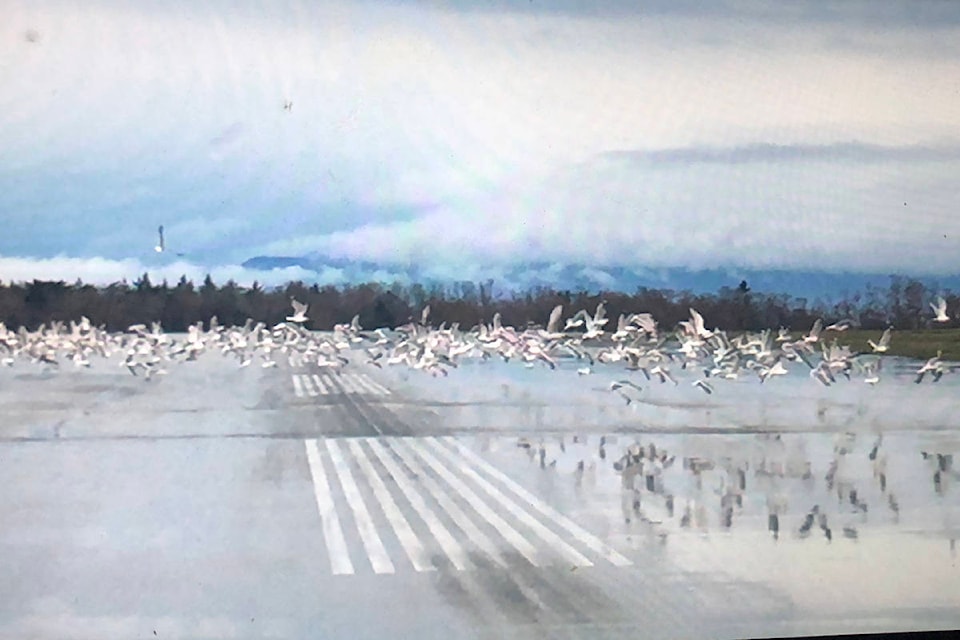Have you noticed that the giant flocks of birds that used to make a point of stopping over at 19 Wing Comox have not been seen for a while?
Due to the hard work and efforts of West Coast Wildlife Control Services (WCWCS) - since 2004 - those flocks found other places to roost.
WCWCS has been contracted to work at 19 Wing Comox to manage birds and other wildlife on the base to ensure the safety of all military and commercial aircraft landing on or departing from the airfield.
Ken Speckeen, the owner and principal of WCWCS, has 42 years of experience in wildlife management, including 18 years as a conservation officer in Manitoba and Alberta.
Sea birds
As with most airports, especially one situated along the ocean, seagulls are considered a major threat to aircraft. On the West Coast, these birds – approximately 4,000 of them – come into the area every fall for the salmon runs in the local rivers. The Comox Valley’s rich riparian ecosystem is enough of a food source to accommodate several thousand gulls.
Generally, these birds would migrate further south after the salmon runs. However, for decades, they did not migrate further because they had found an important food source: the Comox Valley Waste Management Centre. Moreover, on wet, windy and rainy days, these nuisance gulls would feed on the thousands of earthworms that appear on the Wing’s runways due to the saturated soil. The migrating birds, attracted by the landfill, had found a secondary food source on the airfield.
A brief stopover at the airfield could have a serious impact on flight safety - if a bird ever hit an incoming or outgoing aircraft.
WCWCS operates under the premise that the only way to manage problem wildlife is to either remove the wildlife from the food, or remove the food from the wildlife.
Tackling the issue
To tackle the issue of birds on the airfield, WCWCS first ensures that birds do not land or feed on any paved surfaces. Then that concentration of effort is spread out across the airfield to ensure the birds do not get the opportunity to sit and wait for the wildlife management team to leave.
How does WCWCS keep birds off the airfield? The team relies on deterrents that they can control, between sunrise and sunset, including, scaring with noise, including vocal calls, visual scaring using pyrotechnics or controlled lights, and scaring, to some extent, with dogs.
Another subtle but important tactic is to employ trucks with the same markings, as birds are intelligent and learn to identify the markings. Due to the 17-year presence of WCWCS at the Wing, the simple presence of the trucks and staff is enough to deter birds in 2021.
Building success
WCWCS has had tremendous success over the years with an exceptionally low bird strike ratio, calculated by the number of strikes per 10,000 aircraft movements. The Wing’s stellar flight safety record relative to bird strikes is a testament to the success of these softer methods of bird management.
Another factor added to the success in recent years. In September 2018, WCWCS took over the contract of bird control at the Campbell River and Cumberland waste management centres. Remember that those landfills are a primary food source for migrating flocks? The same gull populations frequenting 19 Wing’s runways were the birds feeding at the landfills.
The requirement for having bird control at the landfill is for staff safety, the reduction of spread onto neighbouring properties, and damage the birds cause to equipment and property.
Imagine 4,000 gulls and up to 800 eagles all crammed into a very small area, fighting for any scrap of edible refuse to eat onsite or nearby. It is not good for humans, nor is it good for the wildlife.
When WCWCS took over the wildlife management at the landfills, the goal was exactly the same as with the airport: to keep the birds from feeding and to not allow them to sit or rest anywhere on the property. This was done through constant pressure – with the team working 365 days a year.
Prior to 2018, because the birds were still feeding and wintering in the Comox Valley, the bird numbers continued at the airfield. After 26 months and the everyday pressure at the two landfills, these two landfills may be the only two in British Columbia without a single gull. And because the primary food source became a very uncomfortable pit stop during migrations, now no gulls try to feed the airfield at 19 Wing. Moreover, a single person’s presence at the landfill is all that is needed at this point to keep up the deterrence.
The payoff
On Jan. 12 it was observed that approximately 4,000 gulls gathered in Courtenay and headed further south. Just like they should be doing.
The results on the airfield have been amazing. The combined efforts at both landfills and at CFB Comox has made these areas safer for aircraft, the military and civilian employees at 19 Wing, the employees at the landfills, and the public. This has also resulted in cost savings on equipment and repairs that would otherwise occur with the large numbers of birds.
Right now, there are approximately 95 per cent fewer gulls during the winter months that used to feed and cause damage around the community, all due to the success of the employment of the simple tactic of making stopping at the landfills and at the airfield an uncomfortable experience.
– West Coast Wildlife Control Services
